In the digital world, traffic is the heartbeat of any online presence, especially if you're running a blog, an e-commerce store, or a business website. But when it comes to evaluating traffic, there’s always the question: how much daily traffic will genuinely make you happy? For many, the answer lies in creating a sustainable strategy that includes acquiring theme-related links, focusing on low Keyword Difficulty (KD) keywords, prioritizing Google traffic, leveraging social media, and more. Here’s a comprehensive guide on how to achieve a traffic level that not only satisfies but exceeds your expectations.
1. Setting Your Traffic Goal: Quality Over Quantity
More traffic doesn’t always mean better results. High traffic with low engagement can be misleading, while moderate, high-quality traffic can yield more conversions, sales, and growth. Think about your business goals and identify a number that aligns with your objectives. For a niche blog, 500 to 1,000 daily visitors might be ideal, while larger e-commerce sites may aim for thousands.2. The Power of Theme-Related Links
To increase high-quality daily traffic, focus on acquiring theme-related links. Getting 20+ theme-related backlinks every month can help boost your SEO rankings and improve your visibility. Links from sites within your niche not only improve relevance but also attract visitors who are genuinely interested in your content or products. How to get theme-related links:- Guest post on websites related to your niche.
- Collaborate with influencers or industry experts.
- Engage in content collaborations like interviews or expert round-ups.
3. Choosing Low KD Keywords for Easy Wins
Keywords with low Keyword Difficulty (KD) offer a smoother path to ranking higher on search engine results. These are often long-tail keywords or niche-specific terms with moderate search volumes but lower competition. Ranking for these keywords can bring in consistent traffic that gradually grows as you target more keywords. How to find low KD keywords:- Use tools like Ahrefs, SEMrush, or Moz to filter keywords by low KD.
- Look for niche terms and queries that fit naturally within your content.
- Focus on providing in-depth, high-quality answers to frequently asked questions.
4. Focusing on Keywords with Google Traffic Potential
Not all keywords are equal in terms of traffic potential. Select keywords with a proven track record of attracting organic Google traffic. This approach ensures that your efforts in content creation and SEO optimization are rewarded with visibility in Google’s search results. How to identify keywords with Google traffic:- Use Google Keyword Planner to assess monthly search volume.
- Analyze competitors’ keywords to spot high-traffic opportunities.
- Choose keywords that reflect search intent, such as “how to,” “best,” or “top.”
5. Leverage Social Media for Wider Reach
Social media is a powerful tool for amplifying your reach and driving more visitors to your site. Platforms like Facebook, Twitter, Instagram, and LinkedIn can bring in consistent traffic when used effectively. However, it’s essential to tailor your social media strategy based on where your target audience is most active. How to maximize social media reach:- Share your content regularly and encourage followers to engage with it.
- Use visually engaging elements like images, infographics, and videos.
- Experiment with paid promotions or boosted posts for wider visibility.
